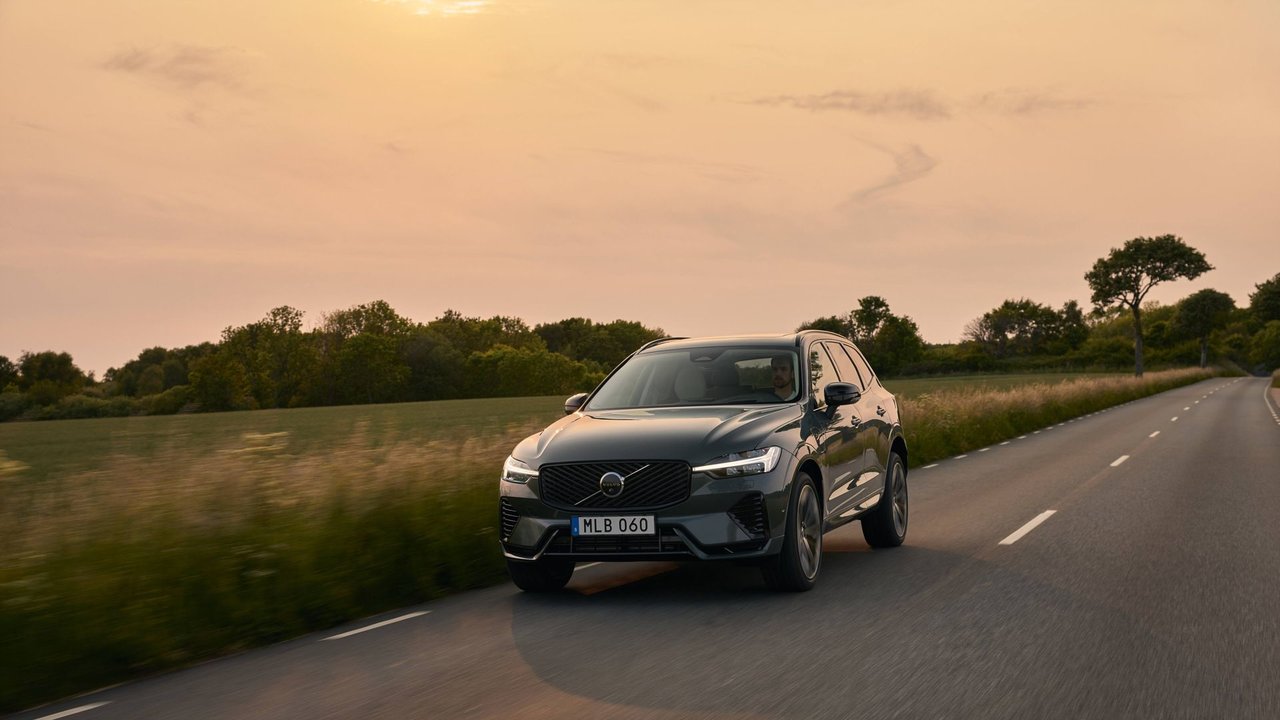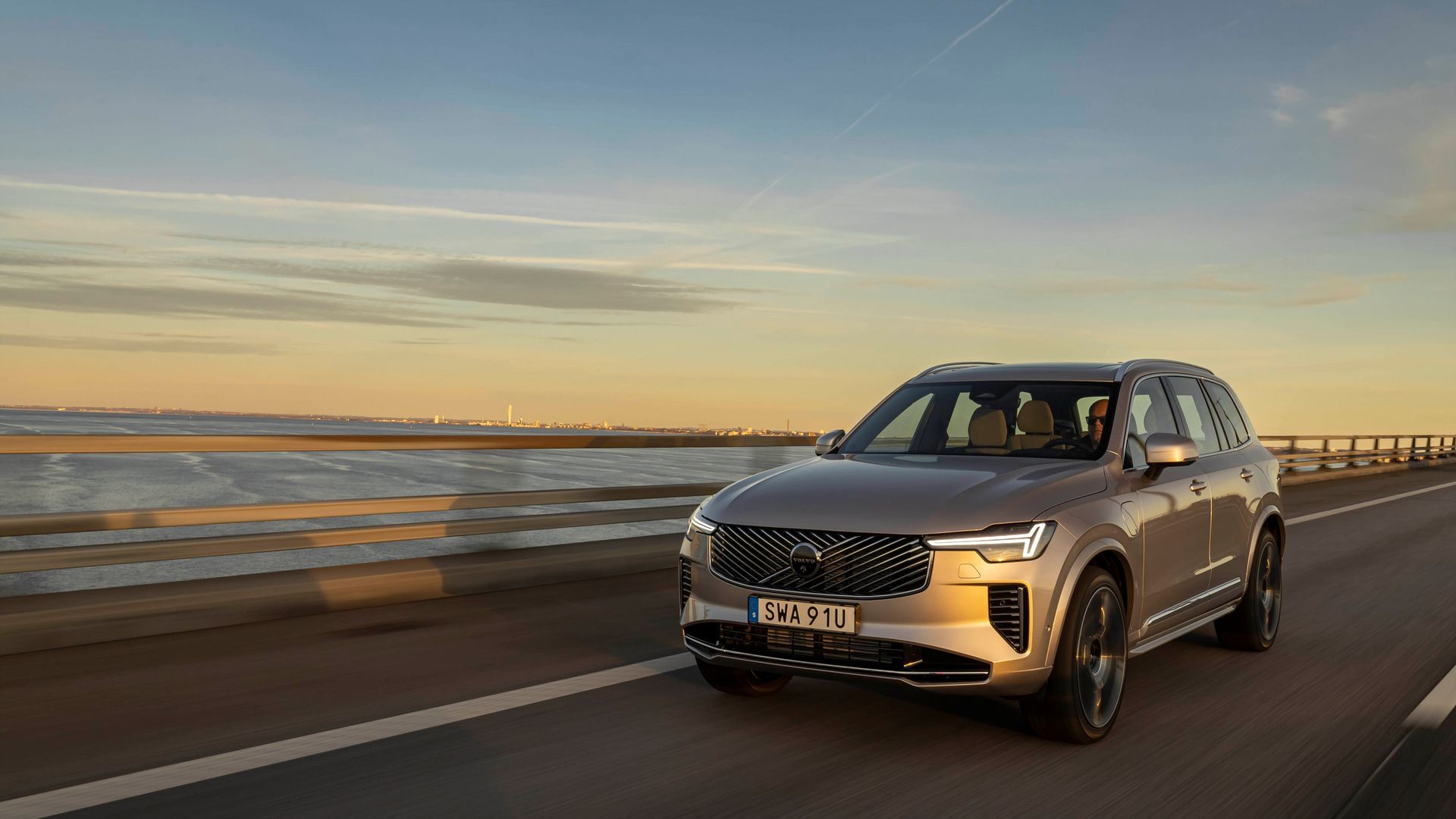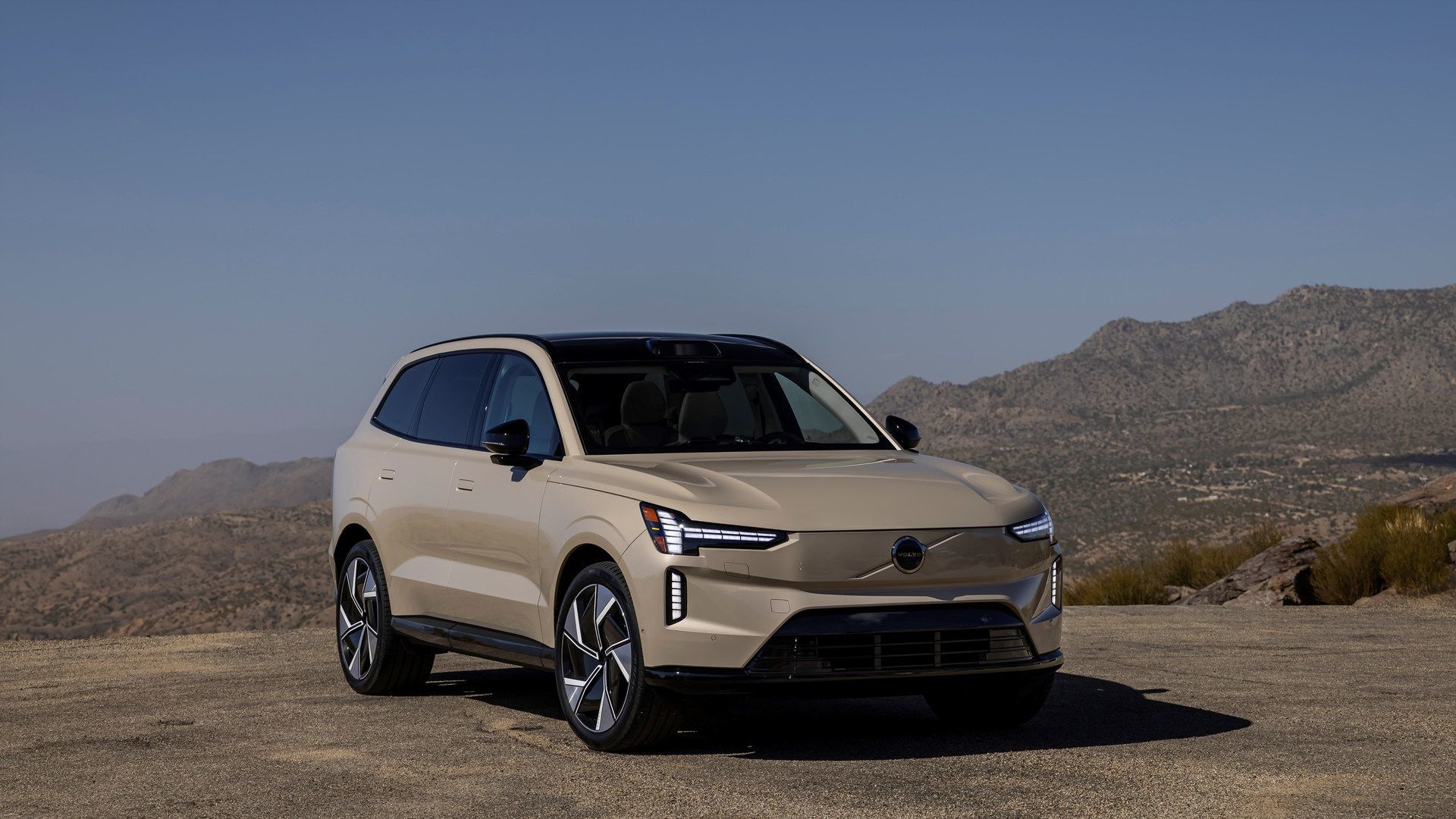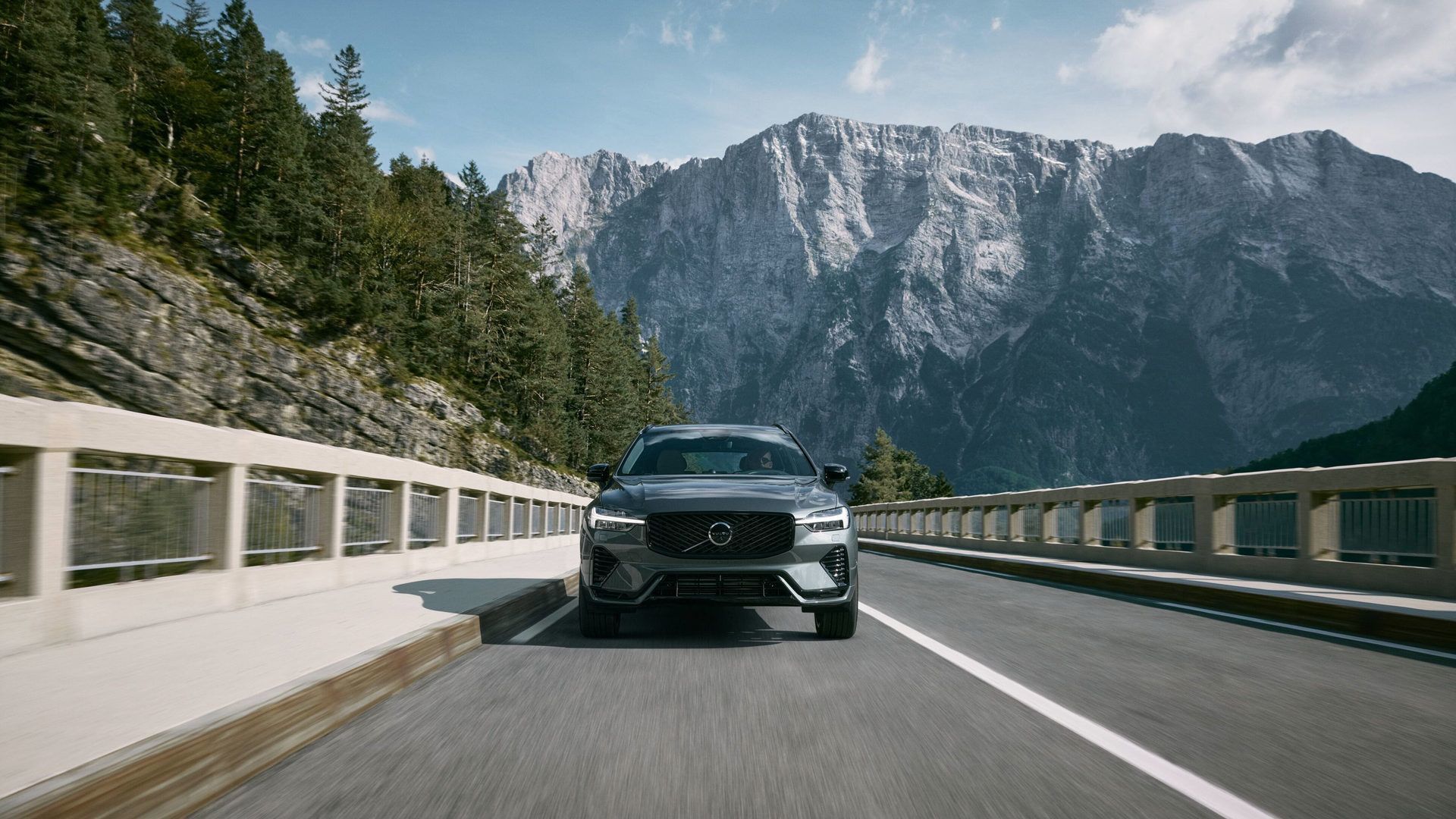
Photo for illustrative purposes only.
Find out moreVolvo Cars Mississauga

Range anxiety continues to influence electric vehicle adoption decisions across Ontario. The concern about depleting battery charge far from charging infrastructure—particularly when traveling to areas with limited charging availability—causes many potential buyers to hesitate despite interest in electric driving benefits.
The Volvo XC60 T8 plug-in hybrid addresses this concern through a dual-powertrain architecture that provides 58 kilometres of all-electric range for daily Mississauga driving while maintaining gasoline-powered capability for extended trips across Ontario and beyond. This configuration eliminates the choice between emission-free local driving and unrestricted long-distance travel, accommodating both within a single vehicle.
Plug-in Hybrid Architecture and Power Flow
The XC60 T8 combines a turbocharged 2.0-litre 4-cylinder gasoline engine producing 312 horsepower with an electric motor generating 143 horsepower. Total combined output reaches 455 horsepower with 523 lb-ft of torque available across the operating range.
An 18.8 kWh lithium-ion battery (14.7 kWh usable capacity) stores electrical energy, providing 58 kilometres of all-electric range under optimal conditions. This capacity covers typical daily driving patterns throughout Mississauga—commuting from Meadowvale to Port Credit, running errands between Square One and Streetsville, or completing school transportation circuits in Erin Mills.
The gasoline engine drives the front wheels through an 8-speed automatic transmission, while the electric motor powers the rear wheels. This through-the-road all-wheel-drive configuration creates constant power distribution to all four wheels when both power sources operate, benefiting traction in variable Ontario weather conditions.
Power flow management operates automatically based on driving demands and battery charge level. In Pure electric mode, only the electric motor operates until battery depletion or power demands exceed its capacity. In Hybrid mode, the system blends electric and gasoline power for optimal efficiency. In Power mode, both sources operate at maximum output simultaneously for peak performance.
Daily Electric Driving Economics
With 58 kilometres of electric range, most Mississauga daily driving occurs without activating the gasoline engine. Common routes fall well within this threshold:
Even combining morning commute, midday errands, and evening return trip often totals under 58 kilometres. The vehicle operates as a pure electric for these journeys, consuming no gasoline and producing no tailpipe emissions.
Charging the 18.8 kWh battery using Ontario's residential electricity rates costs approximately $1.39 during off-peak hours (7:00 PM to 7:00 AM weekdays, plus all weekend hours at $0.074/kWh). This charge provides 58 kilometres of driving—roughly $2.40 per 100 kilometres.
Comparable gasoline-only driving at 9.0 L/100 km costs approximately $15.30 per 100 kilometres with fuel at $1.70 per litre. The difference of $12.90 per 100 kilometres represents substantial savings for high-frequency local driving. A driver covering 15,000 km annually in electric mode saves approximately $1,935 compared to gasoline operation.
Extended Range for Long-Distance Travel
When the battery depletes or is intentionally conserved, the turbocharged gasoline engine provides extended range. With a 71-litre fuel tank and hybrid-mode fuel economy of 8.5 L/100 km, the XC60 T8 can travel more than 835 kilometres on gasoline alone after electric range is exhausted.
This capability eliminates range planning for common Ontario trips:
For these journeys, the XC60 T8 operates like a conventional vehicle—no charging stops required, no route planning around charger locations, and no waiting for charge sessions to complete. Standard fuel stations provide familiar, quick refueling anywhere along the route.
The system can also be configured to preserve battery charge for specific portions of a journey. Hold mode maintains current battery level, allowing drivers to save electric range for emission-free driving in destination city centers or residential areas after completing highway travel on gasoline power.
Charging Options and Infrastructure Requirements
Unlike pure electric vehicles that require regular access to charging infrastructure, the XC60 T8 operates fully on gasoline if charging is unavailable. However, regular charging maximizes efficiency benefits by enabling electric operation for daily driving:
Home charging provides the most convenient option. A standard 120-volt household outlet charges the battery in approximately 12 hours—easily accomplished overnight. Upgrading to a 240-volt Level 2 charger reduces charge time to approximately 5 hours at 16 amps or 3 hours at higher amperage.
Many Mississauga homes have 240-volt outlets in garages (used for electric dryers or welders). Installing a dedicated Level 2 charging station typically requires an electrician to run a dedicated circuit from the electrical panel. Costs vary based on distance from panel to installation location and local electrical codes.
Workplace charging has expanded across Mississauga. Many employers now offer Level 2 charging stations in employee parking areas, allowing workers to recharge during business hours. This effectively doubles daily electric range by providing a second full charge before the evening commute.
Public charging is available throughout Mississauga at shopping centers, municipal lots, and some street-side locations. Level 2 chargers at these locations provide convenient top-up opportunities during longer stops, though the XC60 T8 doesn't require public charging for basic operation the way pure electric vehicles do.
The XC60 T8 doesn't support DC fast charging—only AC charging up to 32 amps. This reflects the plug-in hybrid's smaller battery and the expectation that most charging occurs overnight at home rather than during travel.
All-Wheel Drive Performance and Traction Management
The T8's unique all-wheel-drive configuration—gasoline engine powering front wheels, electric motor powering rear wheels—creates interesting traction characteristics:
During electric-only operation, the vehicle is rear-wheel drive. The electric motor's instant torque delivery benefits traction control systems that can modulate power more precisely than gasoline engines that must build rpm before producing torque.
When the gasoline engine activates, all-wheel drive engages automatically. Both axles receive power simultaneously, with sophisticated traction management monitoring individual wheel speeds and adjusting power distribution to maximize grip on variable surfaces.
Winter driving particularly benefits from this configuration. When accelerating from stops on snow-covered roads, the electric motor's immediate response allows the traction control system to manage rear-wheel slip effectively. If rear wheels lose grip, the gasoline engine's front-wheel power maintains forward progress.
The system's electronic nature allows it to respond within milliseconds to changing traction conditions—far faster than mechanical all-wheel-drive systems that rely on fluid couplings or clutch packs. This speed proves valuable when encountering sudden traction changes like icy patches on otherwise clear pavement.
Real-World Electric Range Factors
The 58-kilometre electric range represents testing under controlled conditions. Real-world range varies based on several factors Ontario drivers encounter:
Temperature significantly affects battery performance. Cold winter conditions reduce available range as battery chemistry operates less efficiently in low temperatures, and cabin heating draws substantial power. At -20°C, electric range may decrease to 35-40 kilometres. Summer heat also impacts range, though less severely—expect 50-55 kilometres on very hot days with air conditioning running continuously.
Driving style influences efficiency. Smooth acceleration, moderate speeds, and anticipation of stops maximize range. Aggressive acceleration, high speeds, and frequent hard braking all reduce how far the battery can propel the vehicle. The difference between efficient and aggressive driving can span 10-15 kilometres of range.
Climate control use draws power from the battery. Heating and air conditioning require significant energy. Pre-conditioning the cabin while plugged in—heating or cooling it before departure while still connected to shore power—preserves battery range for driving.
Route characteristics matter. Flat terrain provides better range than hilly routes requiring frequent elevation changes. Highway driving at sustained high speeds is less efficient than mixed urban driving with opportunities for regenerative braking.
Payload and cargo affect range. Carrying additional weight requires more energy to accelerate and maintain speed. The impact is modest for typical passenger loads but becomes noticeable with maximum cargo or trailer towing.
Comparing Operating Costs: Electric vs. Hybrid Modes
|
Scenario |
Distance |
Energy Source |
Cost per Trip* |
Annual Cost** |
|---|---|---|---|---|
|
Daily Commute (40 km round trip) - Electric |
40 km |
Battery Only |
$0.96 |
$240 |
|
Daily Commute (40 km round trip) - Hybrid |
40 km |
Gasoline |
$6.80 |
$1,700 |
|
Monthly Savings with Electric Operation |
800 km |
-- |
-- |
$1,460 |
|
Weekend Trip to Muskoka (400 km) |
400 km |
Primarily Gasoline |
$34.00 |
-- |
|
Combined Annual Operation*** |
17,000 km |
Mixed |
-- |
$1,080 |
*Based on $0.074/kWh off-peak electricity and $1.70/L gasoline
**Assuming 250 working days annually
***12,000 km local electric + 5,000 km long-distance gasoline
Performance Characteristics and Driving Dynamics
With 455 horsepower and 523 lb-ft of torque available when both power sources operate simultaneously, the XC60 T8 delivers strong performance. Acceleration from 0-100 km/h occurs in 4.8 seconds—entering sports sedan territory despite the vehicle's mid-size SUV format and seven-passenger capacity.
The immediate torque delivery from the electric motor provides responsive acceleration even before the turbocharged gasoline engine builds boost pressure. This characteristic makes the XC60 T8 feel quicker in real-world driving than its specifications might suggest, particularly for the first few seconds of acceleration from stops or during passing maneuvers.
The battery's low mounting position beneath the passenger compartment lowers the center of gravity compared to conventional gasoline-only XC60 models. This positioning reduces body roll during cornering and improves handling stability, despite the additional 230 kilograms the battery and electric motor add to vehicle weight.
Optional air suspension further enhances ride quality and handling. The system automatically adjusts damping rates and can lower the vehicle by 20 mm at highway speeds for improved aerodynamics or raise it by 40 mm for additional ground clearance on rough roads.
Maintenance Requirements and Considerations
The XC60 T8 requires maintenance for both its electric and gasoline components, though the dual-powertrain system creates some complexity:
Gasoline engine follows conventional service intervals—oil changes, filter replacements, and fluid checks occur according to Volvo's maintenance schedule. However, if most driving occurs in electric mode, the engine may run less frequently than in gasoline-only vehicles, potentially extending some service intervals.
Electric motor and battery require minimal maintenance. No oil changes or tune-ups affect the electric drivetrain. The battery includes thermal management systems that maintain optimal operating temperature, protecting longevity through active heating and cooling.
Brake wear typically decreases in hybrid vehicles due to regenerative braking. When slowing, the electric motor operates as a generator, converting kinetic energy back into electricity while slowing the vehicle. This process handles much of the deceleration, reducing reliance on friction brakes and extending pad and rotor life.
Transmission service remains important. The 8-speed automatic transmission requires fluid changes at specified intervals. The transmission handles significant torque from the combined powertrains and operates in challenging conditions when blending electric and gasoline power.
Battery longevity concerns many potential hybrid buyers. Volvo provides substantial battery warranty coverage, and modern lithium-ion batteries demonstrate good longevity. However, all batteries degrade over time. After 8-10 years, expect some reduction in capacity and electric range, though the gasoline engine ensures the vehicle remains fully functional.
Cargo Capacity and Interior Space
The XC60 T8's battery placement under the rear cargo floor reduces load capacity compared to gasoline-only XC60 models:
Cargo volume measures 468 litres behind the second row with seats upright—approximately 15 litres less than gasoline variants due to the battery's intrusion into underfloo storage. Maximum capacity with rear seats folded reaches 1,395 litres, again slightly less than non-hybrid models.
The cargo floor sits slightly higher than gasoline versions, raising the lift-over height by approximately 20 mm. This modest increase is barely noticeable in practice but technically requires lifting items slightly higher when loading.
Towing capacity reaches 1,580 kilograms when properly equipped—sufficient for small utility trailers, lightweight camping trailers, jet ski trailers, or boat trailers carrying smaller watercraft. The trailer stability assist system monitors trailer movement and can apply individual wheel brakes to counteract sway.
When towing, electric range decreases substantially due to the additional weight and aerodynamic drag. Expect electric-only range to drop by 40-50% when towing even modest trailer weights. However, the gasoline engine's extended range ensures trailer towing doesn't create practical limitations.
Environmental Impact Beyond Tailpipe Emissions
The XC60 T8's environmental advantage extends beyond eliminating tailpipe emissions during electric operation. Ontario's electricity generation mix includes substantial nuclear, hydroelectric, wind, and solar sources that produce minimal carbon emissions compared to fossil fuel generation.
Charging the vehicle in Ontario results in lower total carbon emissions than operating a conventional gasoline vehicle, even accounting for emissions from power generation. The province's relatively clean grid makes electric driving more environmentally beneficial than in regions where coal-fired generation dominates.
Global data from Volvo indicates that approximately 48% of distance driven in long-range plug-in hybrid models uses electric-only power. Drivers with regular charging access and predictable daily routes often exceed this average, particularly if most weekly driving is local with only occasional long-distance trips.
Experience the XC60 T8 at Volvo Cars Mississauga
The Volvo XC60 T8 plug-in hybrid delivers 58 kilometres of all-electric range for daily Mississauga driving while maintaining gasoline-powered capability for extended Ontario trips. With 455 horsepower, 523 lb-ft of torque, and 8.5 L/100 km combined fuel economy in hybrid mode, the system balances efficiency with performance and travel flexibility.
Book a test drive at Volvo Cars Mississauga in Mississauga to experience how the XC60 T8's dual-powertrain system addresses both local electric efficiency and long-distance travel requirements across the Greater Toronto Area and beyond.

Photo for illustrative purposes only.
Find out more
What Mississauga Drivers Should Know Before Buying a Plug-In Hybrid
Plug-in hybrid vehicles occupy a unique space in today's automotive landscape. They provide electric driving for your daily commute while...
Read more
2025 Volvo EX90: Understanding Trim Levels and Features
Volvo's flagship electric SUV arrives with two distinct trim configurations. The 2025 EX90 Twin Motor Plus establishes the baseline equipment...
Read more
5 Safety Features That Make 2026 Volvo SUVs Stand Out in Ontario
Safety has been Volvo's calling card since the company invented the three-point seatbelt in 1959 and made the patent freely available to the entire...
Read more